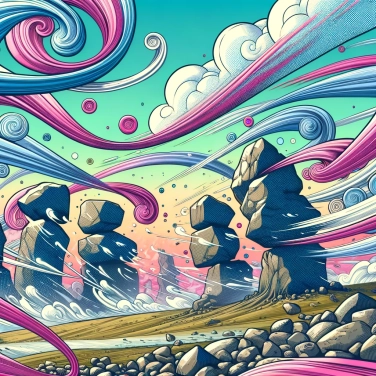Winds can sculpt rocks into strange shapes through a phenomenon called wind erosion. Particles carried by the wind, such as sand, can impact rocks and gradually erode them, giving rise to unique shapes over time.

Wind abrasion is when the wind acts as a sculptor on rocks by launching small grains of sand and particles at high speed. These fragments act as mini-projectiles that gradually wear away the rock. Exposed surfaces become worn, polished, and shaped into bizarre forms. This phenomenon, called mechanical erosion, is particularly strong near the ground, as this is where the most sand lifted by the wind is found. Over time, this repeated action leads to rock structures with improbable shapes, sometimes very thin at the base or riddled with intriguing – and frankly spectacular – holes.
To understand why rocks take on sometimes strange shapes due to the wind, we need to look at different factors. First, the wind speed plays a significant role: fast winds transport sand more easily, which acts as an abrasive by striking the rock. Next, the dominant wind direction gradually carves certain faces of the rocks by wearing them down consistently on the same side. Another important factor is the presence or absence of vegetation and natural obstacles: if objects protect one face, it wears down more slowly, resulting in unique asymmetrical shapes. The climate also plays a role: alternating dry and wet periods can change how the rock withstands erosion. Finally, the height at which the rock is exposed alters its shape because close to the ground, the sand carried by the wind is much more abundant, thus attacking more intensely. All these small aspects combined ultimately create the strange shapes observed in wind-sculpted landscapes.
The type of rock has a huge impact on how it is shaped by the wind. Softer rocks, like sandstone or limestone, are more easily worn away by wind-driven particles and take on really unusual shapes over time. In contrast, harder rocks, like granite or basalt, withstand this abrasion much better; they take longer to change shape and generally have rounder, smoother, or simply less bizarre forms. Another cool thing: some rocks have layers with varying resistances. When the wind blows, the softer layers erode more quickly, creating unique and often spectacular reliefs.
At first, the action of the wind seems weak, almost insignificant. But accumulated over thousands of years, wind erosion gradually transforms the rock, shaping sometimes incredibly bizarre forms. The rock does not hollow out overnight; it is truly a slow erosion caused by tiny grains carried by the wind that continuously scrape the rock. The result? After a long time, we get crooked columns, rock mushrooms, or even delicate arches. As time goes by, the sculpted forms become more complex and impressive: the wind acts as a true patient artist, with each carried grain acting like a mini chisel strike gradually applied to the rock.
The Mushroom Rock in Egypt is a formation known for its amusing mushroom silhouette, shaped mainly by the abrasive action of wind-blown sand. In the United States, in Utah and Arizona, there are rocks like The Wave, which offers a fascinating wavy landscape formed through the methodical effect of sand-laden winds over thousands of years. In Bolivia, the Stone Tree is also a beautiful example: its narrower base and wider upper part perfectly illustrate selective wind erosion that sculpts the rock into improbable shapes. Similarly, in Algeria, the strange eroded rocks of Tassili n'Ajjer sometimes seem to take on the silhouettes of animals or surprising figures, created solely by the wind.
The strange rock formations often called 'yardangs', sculpted by the winds, are sometimes so unusual that in the past they have been mistaken for remnants of lost civilizations or even believed to be sculptures created by extraterrestrials!
There are rock formations on Mars shaped by dust storms, similar to those observed on Earth. Their study helps scientists better understand wind processes on other planets.
The process by which the wind shapes rock is called wind erosion. On a small scale, the same phenomenon explains why certain car windows or glass façades in windy areas gradually become dull or opaque.
Some grains of sand carried by strong winds reach speeds close to 100 km/h, which explains their effectiveness in polishing and shaping even the hardest rocks.
The process is very slow and heavily depends on weather conditions and the hardness of the rocks. Generally, it can take several thousand to several million years to clearly shape visible and remarkable rock sculptures.
Yes, soft rocks like sandstone or limestone are more easily affected and shaped by wind erosion, whereas hard and dense rocks like granite are more resistant.
These rock sculptures are typically found in desert or semi-desert regions, such as the Sahara Desert, the badlands of North America, or the arid landscapes of the American Southwest.
In addition to wind, precipitation, frost/thaw cycles, and the chemical action of mineral salts and water can also alter and shape rocks, creating various types of amazing sculptures.
Yes, as the wind continues to blow and environmental conditions change, these rock formations slowly continue to alter their appearance, modifying or even completely disappearing over time.

No one has answered this quiz yet, be the first!' :-)
Question 1/5